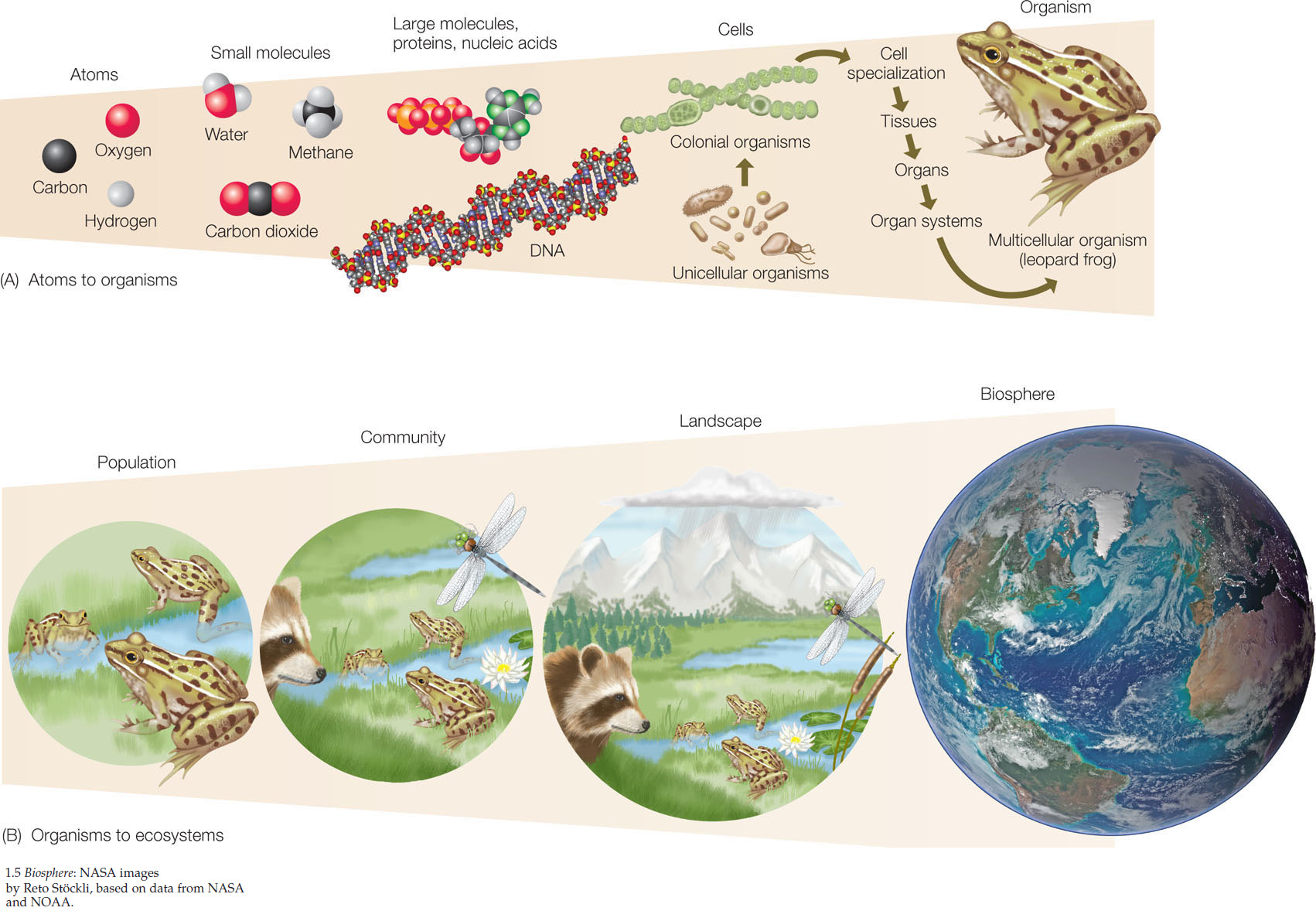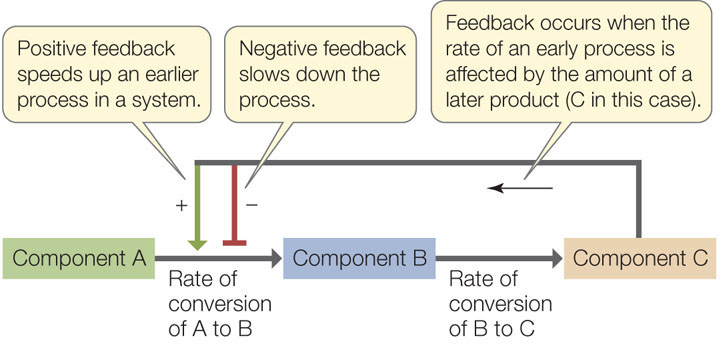CONCEPT1.2 Life Depends on Organization and Energy
All of life depends on organization. Physics gives us the second law of thermodynamics, which states that, left to themselves, organized entities tend to become more random. Any loss of organization threatens the well-being of organisms. Cells, for example, must combat the thermodynamic tendency for their molecules, structures, and systems to lose organization—to become disorganized. Energy is required to maintain organization. For this reason, cells require energy throughout their lives.
Organization is apparent in a hierarchy of levels from molecules to ecosystems
Cells synthesize, or manufacture, proteins and other complex molecules by assembling atoms into new, highly organized configurations. Such complex molecules give cells their structure and enable them to function. For example, a fatty acid molecule that the cell synthesizes may become part of a membrane that structures the inside of the cell by dividing it into compartments. Or a protein made by a cell may enable a specific chemical reaction to take place in the cell by helping start or speed up the reaction—that is, by acting as a catalyst for the reaction.
Organization is also essential for many cells to function together in a multicellular organism. As we have seen, multicellularity allows individual cells to specialize and depend on other cells for functions they themselves do not perform. But the different specialized cells also work together. For example, division of labor in a multicellular organism usually requires a circulatory system so that the functions of specialized cells in one part of the body are of use to cells in other, distant parts of the body.
Overall, a multicellular organism exhibits many hierarchical levels of organization (FIGURE 1.5A). Small molecules are organized into larger ones, such as DNA and proteins. Large molecules are organized into cells, and assemblages of differentiated cells are organized into tissues. For example, a single muscle cell cannot generate much force, but when many cells combine to form the tissue of a working muscle, considerable force and movement can be generated. Different tissue types are organized to form organs that accomplish specific functions. The heart, brain, and stomach are each constructed of several types of tissues, as are the roots, stems, and leaves of plants. Organs whose functions are interrelated can be grouped into organ systems; the esophagus, stomach, and intestines, for example, are all part of the digestive system. Because all these levels of organization are subject to the second law of thermodynamics, they all tend to degrade unless energy is applied to the system. This is why an organism must use energy to maintain its functions.

Matching the internal hierarchy of an individual organism is an external hierarchy in the larger biological world where organisms interact with their physical environment—an ecological system, often shortened to ecosystem (FIGURE 1.5B). Individual organisms interacting with their immediate environment form the smallest ecological system. Groups of individuals of any one species live together and interact in populations, and populations of different species that live and interact in a single area form ecological communities. Multiple communities interact within landscapes. The landscape of the entire Earth and all its life is known as the biosphere.
7
But there are some important differences between biological systems at the organismal level and these larger scales. All the hierarchical levels of organization within an individual organism are encoded by its single genome, so that these levels generally interact harmoniously. By contrast, the external hierarchy of populations, communities, and landscapes involves interactions among multiple species with multiple genomes, so that interactions are not always harmonious. For example, individuals often prevent others of their own species from exploiting a necessary resource such as food, or they exploit members of their own or different species as food.
Each level of biological organization consists of systems
We have already discussed organ systems and ecological systems. More generally, a system is a set of interacting parts in which neither the parts nor the whole can be understood without taking into account the interactions. A simple biological system might consist of a few components (e.g., proteins, pools of nutrients, or organisms) and the processes by which the components interact (e.g., protein synthesis, nutrient metabolism, or grazing) (FIGURE 1.6).

Consider, for example, the system within a cell that synthesizes and controls the quantity of a particular protein, which we’ll call Protein T (FIGURE 1.7A). The components of the system are the amino acids from which Protein T is made, Protein T, and the breakdown products of Protein T. The processes are the biochemical pathways that synthesize and break down Protein T. To understand how the cell controls the amount of Protein T, we must understand how all the other components and processes in this system function.

Systems are found at every level of biological organization. For example, our bodies have a physiological system that controls the amount of sodium (Na+) in our body fluids (FIGURE 1.7B). Grass, voles, and predators (foxes and owls) are components of a community-level system (FIGURE 1.7C).
Biological systems are highly dynamic even as they maintain their essential organization
Given the central importance of organization, you might think that biological systems are inflexible and static. Actually, they are often incredibly dynamic—characterized by rapid flows of matter and energy. On average, for example, a cell in your body breaks down and rebuilds 2–3 percent of its protein molecules per day. Each day it also makes and uses more than 100,000 trillion (1014) molecules of adenosine triphosphate (ATP), the molecule responsible for shuttling energy from sources to uses. Collectively, all the cells in your body liberate more than 90 grams of hydrogen every day from the foods they break down to obtain energy. Your cells also combine that hydrogen with oxygen (O2) to make almost a liter of water every day.
This dynamic aspect of biological systems means that they constantly exchange energy and matter with their surroundings. For example, even after a single-celled or multicellular organism has reached maturity, most of its molecules are steadily replaced. In this ceaseless, dynamic process, atoms are lost from the cells in the organism to the surrounding soil, air, or water, and they are replaced with atoms from the soil, air, or water. Yet as the atomic building blocks of any particular cell come and go, the organization of the molecules, structures, and systems in the cell persists. This fact emphasizes the central importance of organization.
8
Positive and negative feedback are common in biological systems
Often, the amount of one of the components of a system, such as component C in FIGURE 1.8, affects the rate of one of the earlier processes in the system. This effect is called feedback and may be described as positive or negative. Feedback is often diagrammed simply with a line and symbol, but its actual mechanism may be complex.

Positive feedback occurs in a system when a product of the system speeds up an earlier process. The effect of positive feedback is to cause the product to be produced faster and faster. To return to one of our earlier examples, if the breakdown products of Protein T sped up synthesis of Protein T, this would lead to more breakdown products, then even more Protein T, then even more breakdown products, and so on. Positive feedback tends to destabilize a system, but destabilization can sometimes be advantageous, provided it is ultimately brought under control.
Negative feedback occurs when a product of a system slows down an earlier process in the system. Often, as the product increases in amount or concentration, it exerts more and more of a slowing effect. Negative feedback stabilizes the amount of the product in this way: if a high amount of the product accumulates, that accumulation tends to reduce further production of the product. For example, if an increase in the amount of breakdown products of Protein T slowed down synthesis of Protein T, this would lead to a decreased amount of breakdown products and a return to the previous rate of Protein T synthesis. Negative feedback is very common in regulatory systems, which are systems that tend to stabilize amounts or concentrations.
Systems analysis is a conceptual tool for understanding all levels of organization
Biologists today employ an approach known as systems analysis to understand how biological systems function. In systems analysis, we identify the parts or components of a biological system and specify the processes by which the components interact (see Figure 1.6). We may also be able to specify the rates of these interactions and how the rates are affected by feedback. What we can do then is analyze how the system will change through time. Will the amounts of different components increase or decrease, and how quickly, and how will this depend on the rates of the interactions? Will there be any stable balance, or equilibrium, that the system eventually reaches?
To do the analysis we write out mathematical equations that express the amounts of the different components and that include the processes and their rates. Expressed in words, such an equation for component B in Figure 1.6 has the following form:
The amount of B present at some time in the future = the amount of B now + the amount of A converted into B − the amount of B converted into C
We write out a similar equation for each component in the system.
We can analyze the relatively simple biological systems in Figure 1.7 by hand, but the analysis of larger systems quickly becomes very complicated and is typically carried out using computers. The approach, however, is the same: We express the rates of all processes as mathematical equations.
9

After this analysis is done, we have a computational model of the biological system. If the computational model is well grounded in factual knowledge of the biological system, the model will mimic the biological system.
An important use of computational models is prediction. For instance, if atmospheric temperature affects a biological system, we can use a computational model to develop a hypothetical prediction of the future behavior of the system in a warming world by adjusting the model to take into account the expected increases in temperature.